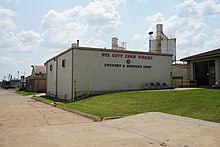바그디(카스테)
Bagdi (caste)| 인구가 많은 지역 | |
|---|---|
| 서벵골 주 | 3,058,265[1] |
| 언어들 | |
| 벵골어 | |
| 종교 | |
| 힌두교의 | |
바그디족은 인도의 서벵골주와 방글라데시에서 발견되는 드라비다 계통의 사람들의 후손으로, 경작과 어업과 같은 직업과 관련이 있었습니다.[2][3]그들은 둘레이 카스트와 관련이 있습니다.[4]바그디족은 웨스트 벵골 서부 변두리의 반쿠라, 비르품 및 기타 지역에 인구가 많습니다.바그디족과 둘레이족은 서벵골주에서 가장 많은 예정된 카스트를 나타냅니다.[5][6][7]Bagdis는 스스로를 'Barga Kshatriya'라고 주장합니다.[8][9]
역사
J.N 바타차리아는 바기스 부족을 어부, 나무꾼, 쓰레기 운반자로 묘사했습니다.바기스 부족은 또한 영국의 범죄 부족법에 따라 벵골의 범죄 부족으로 알려졌습니다.[3]
인구 및 문해력 데이터
2001년 인도 인구조사에서 바그다 이스의 수는 서벵골주의 2,740,385명이었고 웨스트벵골의 카스트 예정 인구의 14.9%였습니다. 바그다 이스의 47.7%는 글을 읽고 쓸 수 있었습니다 – 60.4%의 남성과 34.8%의 여성이 글을 읽고 쓸 수 있었습니다.[10]
참고 항목
참고문헌
- ^ "A-10 Appendix: District wise scheduled caste population (Appendix), West Bengal - 2011". Office of the Registrar General & Census Commissioner, India (ORGI).
- ^ Rahman, S M Mahfuzur (2012). "Bagdi". In Islam, Sirajul; Jamal, Ahmed A (eds.). Banglapedia: National Encyclopedia of Bangladesh (Second ed.). Asiatic Society of Bangladesh.
- ^ a b 로이, 밀란."벵골의 바그디 카스트의 상황적 사회 구조." 카스트, 성별 및 미디어: 인도의 중요한 사회학적 경향: 102.
- ^ B S Baviskar; George Mathew (2009). Inclusion and Exclusion in Local Governance: Field Studies from Rural India. SAGE Publications India. p. 117. ISBN 978-8-13210-089-8.
- ^ "Scheduled castes in West Bengal".
- ^ Nielsen, Kenneth Bo (22 February 2018). Land Dispossession and Everyday Politics in Rural Eastern India. Anthem Press. ISBN 978-1-78308-748-8.
- ^ Mondal, Amrita (6 April 2021). Owning Land, Being Women: Inheritance and Subjecthood in India. Walter de Gruyter GmbH & Co KG. ISBN 978-3-11-069049-1.
- ^ Dasgupta, Satadal (1993). Caste, Kinship, and Community: Social System of a Bengal Caste. Orient Blackswan. p. 32. ISBN 978-0-86311-279-9.
- ^ Banerjee, Milinda (19 April 2018). ‘The Mortal God': Imagining the Sovereign in Colonial India. Cambridge University Press. ISBN 978-1-107-16656-1.
- ^ "West Bengal, Census of India 2001, Data Highlights – The Scheduled Castes" (PDF). Office of the Registrar General, India. Retrieved 28 June 2009.



